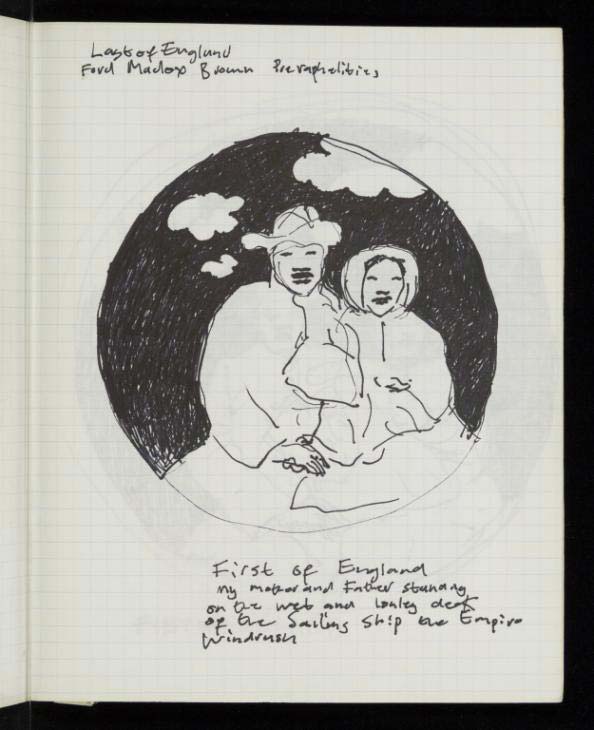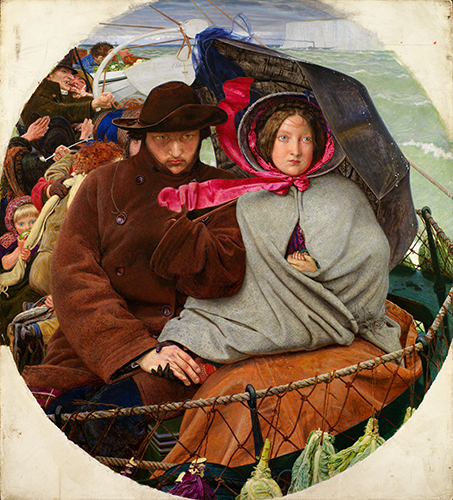In Conversation: Race, Empire and the Pre - Raphaelites
Curator Victoria Osborne and Art Historians Sabrina Rahman and Kate Nichols co-lead the British Art Network Research Group ‘Race, Empire and the Pre-Raphaelites’. Their collaboration, based on the city of Birmingham’s collections managed by Birmingham Museums Trust, explores the potential for rethinking Pre-Raphaelite and Arts and Crafts objects through the lenses of anti-racism and decoloniality. In this ‘In Conversation’ piece, they discuss their research aims, outline their work so far, and reflect on the challenges they’ve faced.
Dr Kate Nichols, Victoria Osborne, Dr Sabrina Rahman
Collection: Birmingham Museums Trust
Keywords: Pre-Raphaelite, Arts and Crafts, Race, Decolonising, Empire
Download a PDF of this article
Fig.1 Donald Rodney, The First of England (1983), ink on paper, 20.5 x 16 cm, Tate Archive (TGA 200321/3/1), artwork © The estate of Donald Rodney, digital image © Tate released under Creative Commons CC-BY-NC-ND (3.0 Unported).
Introducing Race, Empire and the Pre-Raphaelites
Victoria Osborne (VO):
Race, Empire and the Pre-Raphaelites is a research group of the British Art Network (BAN), which is led and supported by Tate and the Paul Mellon Centre for Studies in British Art with funding from the National Lottery through Arts Council England. Ours is a new group for 2020-21, currently funded until September of this year.
Kate, Sabrina and I formed the group to bring together museums holding Pre-Raphaelite and Arts and Crafts material with academics and artists to think about these objects’ global contexts, particularly in relation to ideologies of Orientalism and Empire. By using Birmingham's rich collections as a starting point, we wanted to facilitate broader conversations about how these objects, and collections of Victorian art and design more generally, might be viewed through the lenses of anti-racism and decoloniality, and how they could be displayed and interpreted for the 21st century museum and its diverse audiences.
When we came to pick an image to represent the group on our blog and social media, we chose a sketch in Tate’s collection by Birmingham-born artist Donald Rodney (1961-1998), one of the founders of the British Black Arts movement of the 1980s (fig.1). Rodney’s drawing was made during or following a visit to Birmingham Museum and Art Gallery and responds to one the most famous of all Pre-Raphaelite paintings, Ford Madox Brown’s The Last of England (c.1852-1855) (fig.2). Rodney’s drawing First of England (c.1983) replaces Brown’s white emigrants to Australia with the artists’ own parents arriving in Britain from the Caribbean on the Empire Windrush. The drawing seemed to sum up the central aim of the group: to defamiliarise well-known works of art and to decentre them, viewing them from different perspectives.
Fig.2 Ford Madox Brown, The Last of England (1852-1855), oil on panel, 82.5 x 75 cm, Photo by Birmingham Museums Trust, licensed under CC0.
Aims and activities: starting conversations
Kate Nichols (KN):
The Research Group really aims to start conversations about the relationships between race, imperialism and nineteenth-century art and design collections (especially those with significant, and celebrated Pre-Raphaelite works). In order to start – and indeed sustain – these conversations, we’ve hosted 2 workshops, and one public facing event so far. In each of these events we’ve sought to reach a wide range of people engaged in researching, curating, and working in museums with one or more of our key terms: race, empire, and nineteenth-century art and design. One of the outcomes of the project will be a set of open access resources for museum practitioners working with nineteenth-century collections, which will be available on our website. We are still consulting with our network members about what the format of these resources, but they will likely include case studies of objects, and questions to think about when reframing collections.
BAN research group events have tended to be smaller, in-person gatherings at regional museums. Covid restrictions have meant that all our events have taken place on zoom; obviously there are many disadvantages to this (especially in terms of networking), but it has enabled us to include a geographically broad range of participants, including speakers based in North America and Australia. At present we have 65 Research Group members. These include academics (from MFA and PhD candidates to professors), based primarily in the UK but also the US and France; museum professionals at all career stages, from institutions across the UK and the US; UK-based artists and designers.
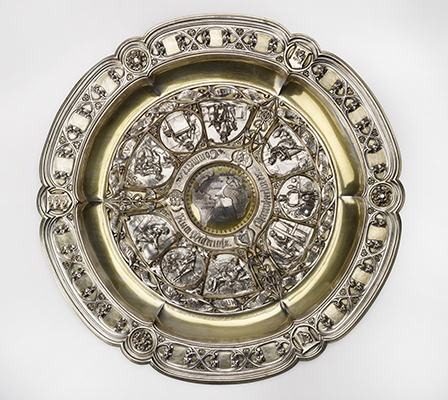
Fig.3 John Leighton, designer, Elkington, Mason and Co., manufacturers, Commemorative tray or tablet (c. 1851), electroformed and electroplated copper, partly gilded, 3 x 32.5 cm, Birmingham Museums Trust, 1973. M18.
Our first, introductory event was ‘Objects in Focus: Decolonising Victorian Art and Design?’ held in January 2021. This brought together 3 pairs of speakers to offer 5-minute responses to 3 objects from Birmingham’s nineteenth-century collections, reframing them in terms of race and empire (figs.2, 3, 4). It was followed by workshops in breakout rooms, where participants considered a range of objects from Birmingham’s nineteenth-century collections and discussed how they might be reinterpreted.
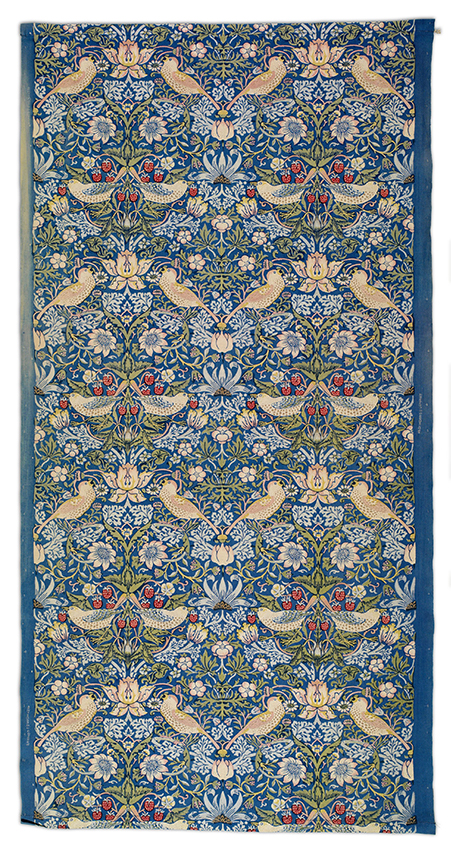
Fig.4 William Morris, designer, Thomas Wardle & Co., printer, Strawberry Thief (design registered 1888), Indigo-discharge block-printed cotton, 196 × 95 cm, Birmingham Museums Trust, 1941M402. Photo by Birmingham Museums Trust, licensed under CC0.
The second workshop took place in May 2021. Titled ‘Artists in Dialogue: Contemporary responses to nineteenth-century art, design and Empire’, this centred around presentations by artists Sunil Gupta, Belinda Kazeem-Kaminski, Farwa Moledina and Bharti Parmar, with discussion chaired by Dr Anna Arabindan-Kesson. These talks explored the ways in which contemporary artists of colour are engaging with nineteenth-century art, design and empire in their practice. In breakout rooms after these presentations we went into further detail about the challenges, limits and potential of displaying contemporary artists’ work to challenge racism and colonial violence in historic collections.
The third event was a public facing roundtable, ‘In Conversation: Hew Locke and Matt Smith: Commemorating and Contesting Empire with Victorian Ceramics’, chaired by Dr Sadiah Qureshi. This explored the complex ways in which two prominent contemporary artists have engaged with Victorian ceramics in public collections to draw attention to racism and colonial violence. Both Locke and Smith discussed the tension between the aesthetic appeal of art objects, and the violent histories that they represent. Locke’s description of his work as ‘like fly-fishing’, a process of luring viewers in with aesthetically engaging objects, only to confront them with the complex, often ugly histories with which they are associated will stay with me for a long time. It seems one way in which museum professionals might harness the aesthetic appeal of difficult objects, to generate curiosity and start deeper conversations.
Challenges and opportunities
Sabrina Rahman (SR):
Discussions about decoloniality and anti-racism have been rife over the past year, and with that have come opportunities as well as challenges. In the initial stages of writing our application for the BAN bursary, we all felt a personal unease with using the word ‘decolonising’ in the name of the Research Group ̶ decolonisation has become such a buzzword in academic circles, and unfortunately much of the recent debate has lacked a sincere commitment to dismantling hegemonic structures in museums and higher education. For example, Eve Tuck and K. Wayne Yang warned about such empty practices in their 2012 article ‘Decolonization is not a metaphor’, and sadly it seems that not much has shifted in the past decade, especially in terms of making meaningful change [1]. In the end, however, we decided that the word had to be used; we do believe that we still need to try to decolonize collections, and we saw the development of this Research Group as an opportunity to effect change on a micro-level. Bringing together a range of people working with similar collections of nineteenth-century objects, we are working towards producing a set of resources to assist museum practitioners in challenging conventional narratives. Our intention is to grant agency to stories that have been marginalized or omitted in the history of Victorian art and design.
Another challenge that we are conscious of is the fact that the sector is overwhelmingly white. We were hoping to reach out to a more diverse demographic, and while I believe we have succeeded in creating a network that includes more people of colour than is usually the case in art and design history, there is still a lot of work to do. When we were advertising our first event on Twitter, one scholar of colour noted their enthusiasm for the subject of the Research Group and our activities, but asked directly how many people of colour were involved with the group, and how will white scholars in the group approach race and empire. This prompted us to develop a sort of ‘decolonial code of ethics’ to shape our activities and open discussions at events. Building on our response to this Tweet, we have made it clear that BIPOC speakers will be in the majority at all of our events, and we seek to maximise BIPOC representation within the group in a way that disrupts the tokenisation that is frustratingly all too prevalent in many initiatives aimed at decoloniality and anti-racism.
We follow the guidelines published in the Royal Historical Society “Race, Ethnicity & Equality” report, and have made good use of our small-ish budget in ensuring that precariously employed speakers are remunerated fairly for their labour [2]. We have also asked that white members of the Group critically reflect on their positionality in relation to race, empire and privilege, and demonstrate a commitment to the decolonisation of institutions and anti-racist activity. We have included this last point very clearly in our introductory blog post, and have reiterated it verbally at the start of each event. One piece of feedback we received from Event 2 was that this code of ethics might have made participants uncomfortable and therefore reticent to speak in breakout rooms--we actually took this as a positive, as we believe that a level of discomfort on the part of white members is necessary in order to reframe the histories of these objects and collections.
KN:
Hosting events online would not have been our first choice, but we have found that the use of breakout rooms to ensure all participants are able to be involved in discussion, and get to know about each other's research interests has been a real success. We have been careful to respond to and reflect on feedback from each session; this has included making sure that breakout rooms have facilitators to ensure that discussion remains on topic and inclusive. We have put together guidelines for facilitators, which has been very helpful. Feedback from our first session suggested that the practical focus on objects, and the chance for museum professionals and academics to discuss specific ‘how to’ questions has been a real success. It was brilliant to see questions and ideas raised by new academic research being practically applied to museum interpretation; for example, from Dr Caitlin Beach’s project on race, labour, materials and nineteenth-century sculpture (fig.3). Engaging with contemporary artists has opened up new questions and perspectives on nineteenth-century art objects for all of us. It has been really invigorating!
Future plans
VO:
We plan to apply for a further bursary from BAN this autumn, and if we’re successful we’ll be able to organise more events and workshops over the next two years. Sabrina is also applying for an AHRC research networking grant which would enable us to extend and build on the Group’s activity to date.
Meanwhile we’re working on producing a set of resources aimed at museums and academics wishing to foreground race and empire in Victorian art and design collections, which we will make available online. We hope that these resources, together with the recordings from our events, will help disseminate the group’s learning in the wider sector, and also support museum staff in gaining confidence discussing these complex and difficult histories and in exploring them in their displays and programmes.
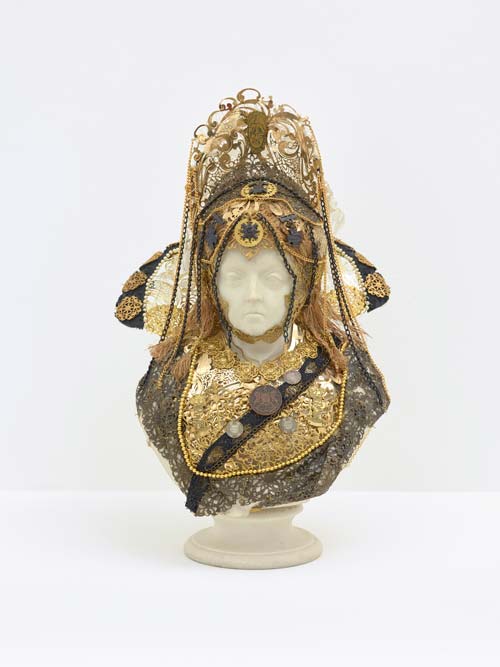
Fig.5 Hew Locke, Souvenir 9 (Queen Victoria) (2019) Mixed media on nineteenth-century Parian Ware, 44.1 x 27 x 26 cm, Birmingham Museums Trust, Photo Hales Gallery/Anna Arca.
The conversations we’re having in the research group are also helping to inform acquisitions and display plans at Birmingham Museums. We recently acquired a sculpture by Hew Locke (b.1959), Souvenir 9 (Queen Victoria) (c.2019) (fig.5), with the help of funding from the Public Picture Gallery Fund, Art Fund, V&A Purchase Grant Fund and the Friends of Birmingham Museums. Locke’s Souvenir series engages with Victorian Parian ware ceramics to explore ideas around national mythmaking and the burden of history, so it aligns very closely with the interests of Race, Empire and the Pre-Raphaelites in exploring the contemporary resonances of historic objects. It was really exciting to be able to add such a significant work to the city’s collection and we’re looking forward to displaying it in Birmingham once the Museum and Art Gallery reopens.
Find out more about Race, Empire and the Pre-Raphaelites, and watch recordings of previous events at the blog or follow the group on Twitter - @race_empire_prb.
About the authors
About the authors
Victoria Osborne is Curator (Fine Art) and Curatorial Team Leader at Birmingham Museums Trust.
Dr Sabrina Rahman is Lecturer in Art History and Visual Culture at the University of Exeter.
Dr Kate Nichols is Birmingham Fellow in British Art at the University of Birmingham.
Acknowledgements
Acknowledgements
The Race, Empire and the Pre-Raphaelites Research Group is a sub-set of the British Art Network, which is jointly overseen by Tate and Paul Mellon Centre for Studies in British Art and Tate. We are grateful to Tate, the Paul Mellon Centre, and the National Lottery through Arts Council England for funding this work.
Endnotes
[1] Eve Tuck and Y. Wayne Yang, “Decolonization is not a metaphor”, Decolonization: Indigeneity, Education & Society, 1.1, 2012, 1-40
[2] Hannah Atkinson, Suzanne Bardgett, Adam Budd, Margot Finn, Christopher Kissane, Sadiah Qureshi, Jonathan Saha, John Siblon and Sujit Sivasundaram, Race, Ethnicity & Equality in UK History: A Report and Resource for Change (London, 2018).
